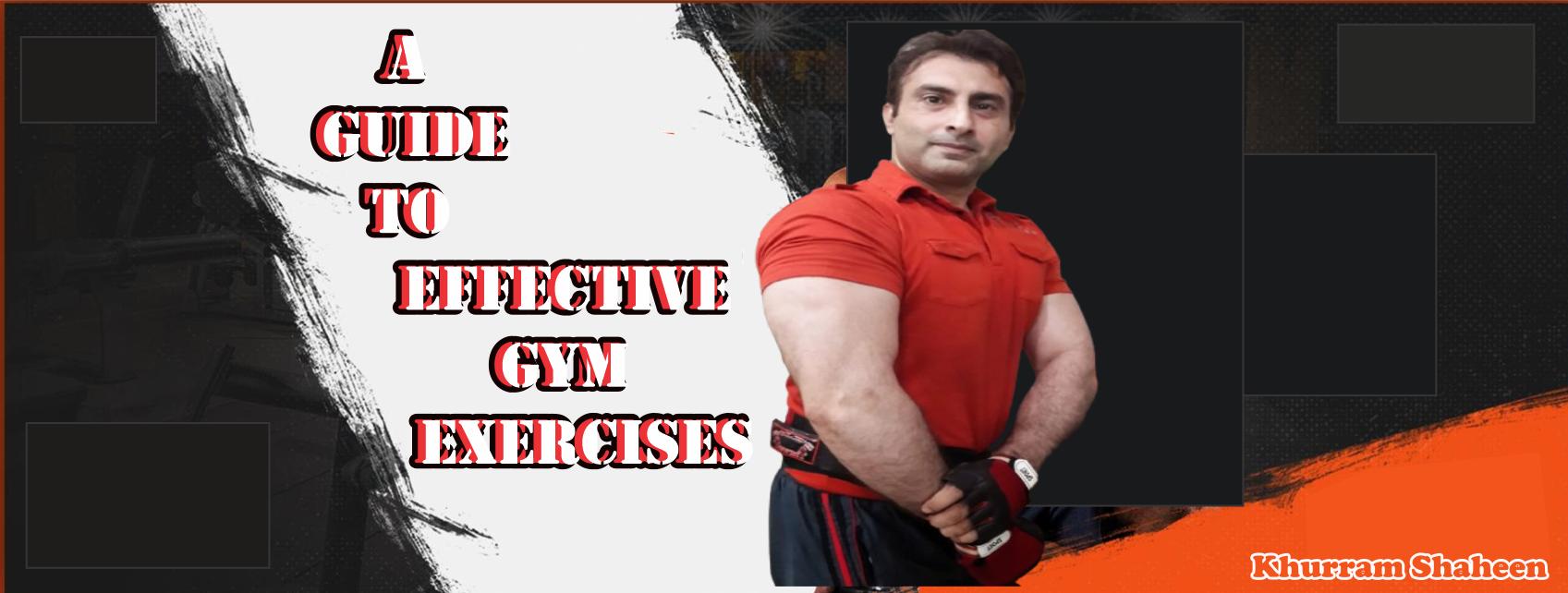
A Guide to Effective Gym Exercises for a Stronger, Healthier You
Whether you're new to the gym or a seasoned fitness enthusiast, understanding the different types of exercises and their benefits is essential to creating a well-rounded workout routine. In this blog, we'll dive deep into the world of gym exercises, explore different types, and provide tips for maximizing your workout's effectiveness. Let’s break down the fundamentals of gym exercises to help you reach your fitness goals faster and more efficiently.
1. Understanding the Basics: Why Gym Exercises Matter
Gym exercises are an excellent way to improve your physical fitness, build strength, enhance endurance, and maintain overall health. Regular exercise can have several benefits, including:
- Building Muscle Mass: Weightlifting and resistance training help you build muscle, which can increase metabolism and improve body composition.
- Boosting Cardio Health: Aerobic exercises like running, cycling, and swimming strengthen your heart and lungs.
- Enhancing Flexibility and Mobility: Stretching and mobility exercises reduce the risk of injury and improve your overall functional movement.
- Mental Health Benefits: Regular exercise is known to boost mood, reduce stress, and improve sleep quality.
2. The Different Types of Gym Exercises
The first step in creating an effective gym routine is understanding the different types of exercises. Gym exercises can be broadly categorized into the following:
a) Cardiovascular (Cardio) Exercises
Cardio exercises are designed to increase your heart rate and improve cardiovascular health. These exercises typically involve large muscle groups and are great for burning calories and improving stamina. Examples include:
- Treadmill Running/Walking: A great option for beginners to advanced athletes, running on a treadmill can be adjusted for different levels of intensity.
- Cycling (Stationary Bike): Cycling is a low-impact option that offers excellent cardiovascular benefits while reducing stress on the joints.
- Rowing Machine: Engages both upper and lower body, providing an excellent full-body cardio workout.
- Jump Rope: A fun, dynamic cardio exercise that can be done anywhere and provides great conditioning.
Benefits: Boosts heart health, burns fat, improves endurance, and helps with weight loss.
b) Strength Training (Resistance) Exercises
Strength training focuses on building muscle by challenging your body with resistance. This resistance can come from free weights, machines, or bodyweight exercises. Strength training is key to increasing lean muscle mass and improving bone density.
Examples:
- Free Weights (Dumbbells, Barbells): Exercises like bench presses, squats, deadlifts, and shoulder presses engage multiple muscle groups and promote strength development.
- Bodyweight Exercises: Push-ups, pull-ups, squats, and lunges are all great bodyweight exercises that can be done without equipment, targeting different muscle groups.
- Resistance Machines: Machines like the leg press, lat pull-down, and chest press can help you target specific muscles and control the weight more easily.
Benefits: Increases muscle mass, boosts metabolism, improves bone health, and enhances functional strength.
c) Flexibility and Mobility Exercises
Flexibility and mobility exercises are designed to improve your range of motion and decrease the likelihood of injuries. These exercises also aid in recovery and promote muscle relaxation.
Examples:
- Stretching: Static stretching (holding stretches for 15–30 seconds) and dynamic stretching (active movements like leg swings and arm circles) both improve flexibility.
- Yoga: A great practice for enhancing both flexibility and mobility while also reducing stress and tension in the body.
- Foam Rolling: A form of self-myofascial release that targets muscle knots and tightness, helping to improve mobility and reduce soreness.
Benefits: Improves posture, reduces muscle stiffness, enhances flexibility, and speeds up recovery.
d) Core Exercises
Your core is the foundation of almost every movement you perform. A strong core improves posture, balance, and stability, and reduces the risk of injury.
Examples:
- Planks: Hold a plank position to strengthen your abs, obliques, and lower back.
- Russian Twists: A rotational movement that targets the obliques.
- Leg Raises: Focus on the lower abs and hip flexors.
- Cable Woodchops: Engage the entire core by performing a twisting motion using a cable machine.
Benefits: Enhances balance, posture, and stability, supports everyday activities, and prevents back pain.
3. Creating an Effective Gym Workout Plan
A well-structured workout plan should combine different types of exercises, allowing you to target all aspects of fitness, including strength, cardiovascular health, and flexibility. Here's how you can structure your weekly gym routine:
Example Workout Plan (3–5 Days Per Week)
- Day 1: Upper Body Strength Training
- Bench Press: 4 sets of 8–12 reps
- Dumbbell Rows: 3 sets of 10–12 reps
- Shoulder Press: 3 sets of 10 reps
- Bicep Curls: 3 sets of 12 reps
- Tricep Dips: 3 sets of 12 reps
- Day 2: Lower Body Strength Training
- Squats: 4 sets of 8–12 reps
- Deadlifts: 4 sets of 6–8 reps
- Lunges: 3 sets of 10 reps per leg
- Leg Press: 3 sets of 12 reps
- Calf Raises: 4 sets of 15 reps
- Day 3: Cardio & Core
- 30-45 minutes of steady-state cardio (running, cycling, or rowing)
- Planks: 3 sets of 30-60 seconds
- Russian Twists: 3 sets of 15 reps per side
- Leg Raises: 3 sets of 15 reps
- Day 4: Active Recovery or Yoga
- Gentle yoga or stretching routine for 30-45 minutes
- Focus on deep stretching and mobility exercises to improve flexibility
- Day 5: Full-Body Workout
- Circuit-style workout involving both strength and cardio exercises
- Example: 10 push-ups, 15 squats, 30 seconds of jumping jacks, 20 kettlebell swings, repeat for 4–5 rounds.
4. Tips for Maximizing Your Workout
- Warm-Up Properly: Always start your workout with a proper warm-up to increase blood flow and reduce the risk of injury. Include dynamic stretching or light cardio to get your muscles ready.
- Focus on Form: Prioritize proper form over the amount of weight you’re lifting. Poor technique can lead to injury and reduced workout effectiveness.
- Rest and Recovery: Allow your body adequate rest between workouts, especially when focusing on strength training. Aim for at least 48 hours of recovery for muscle groups worked intensely.
- Nutrition Matters: Fuel your body with proper nutrition. A balanced diet with adequate protein, carbohydrates, fats, and hydration will support your fitness goals. Consider refueling with protein after strength workouts to promote muscle repair.
- Track Your Progress: Whether through a fitness journal or an app, keep track of your workouts, progress, and goals. Tracking allows you to assess what's working and adjust accordingly.
5. Conclusion: Stay Consistent and Patient
Gym exercises are an essential part of maintaining a healthy lifestyle. With a balanced mix of cardio, strength training, flexibility, and core work, you'll be well on your way to improving your overall fitness. Remember, consistency is key — don’t rush the process. Over time, you’ll see improvement in strength, endurance, and overall health. Stick with it, and enjoy the journey to becoming the best version of yourself!








